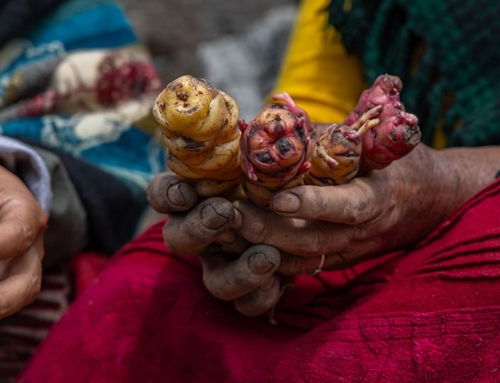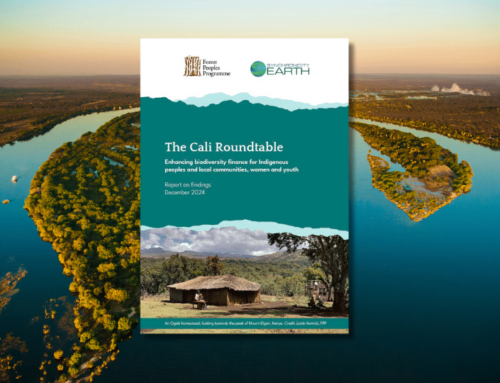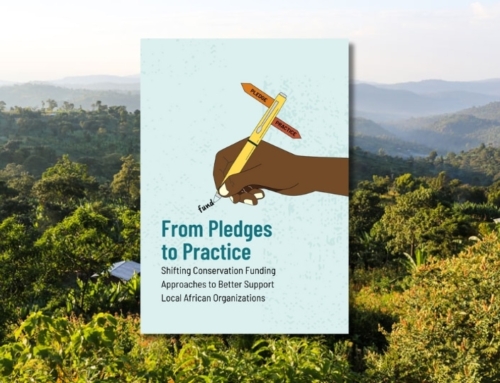With a wave of new pledges of large grants to environmental organisations, as funders, we need to reflect on how our philanthropy can be improved. Building trust between donors and grantees plus reshaping the donor community so it can better support the organisations working on the ground are the foundations of a philosophy and approach gaining momentum in the environment movement: trust-based philanthropy.
Nina Seale reflects on a discussion convened by Reverse the Red discussing the need for environmental philanthropy to evolve and looks at Synchronicity Earth’s relationships with programme partners.
‘Record USD 5 billion donation to protect nature could herald new green era of giving.’ (September 2021)
Governments and private funders announce historic USD 1.7 billion pledge at COP26 in support of Indigenous Peoples and local communities.’ (November 2021)
‘USD 12 billion donor support to halt and reverse forest loss and protect land rights.’ (November 2021)
After the biodiversity and climate Conferences of the Parties (COPs) in 2021, a series of grand headlines appeared, filled with promises of billions of dollars of new funding.
These commitments offer opportunity and optimism, yet despite their impressive size, they are a mere drop in the ocean in terms of what is needed to reverse nature’s decline, and there is no guarantee that the funding they provide will go where it is most needed and most effective. Philanthropy and overseas aid have long fallen short of their missions, often in part due to an unacknowledged power imbalance between donors and their grantees, and funding not reaching those that need it most.
However, with these pledges comes a growing need to acknowledge the importance of centring the voices of Indigenous Peoples and local communities throughout the grant-giving process and place trust at the heart of environmental philanthropy.
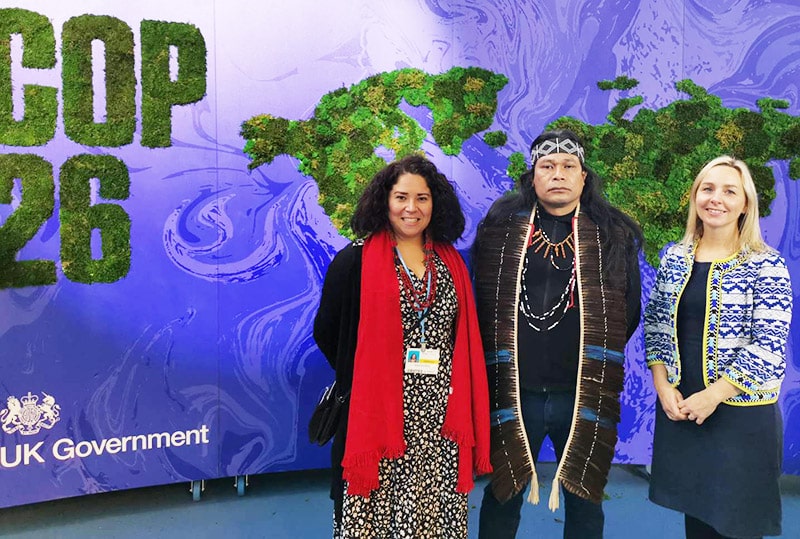
For the first time in the history of the United Nations (UN) Framework Convention on Climate Change, twenty-eight indigenous peoples were nominated from each of the seven UN indigenous socio-cultural regions at the UN Climate Change Conference COP26 in Glasgow in November 2021. Here Synchronicity Earth affiliate Grace Souza meets with Rivelino Verá Popygua, Chief of the Mbya Guarani People, and Barbara Davies Quy, Deputy Director of Size of Wales at COP26.
The future of conservation is local
In a panel discussion held by Reverse the Red about how conservation funding can maximise local action and impact, five speakers from both the donor and grantee communities discussed the barriers to effective funding, and solutions which are seeing success.
Following the commitment of USD 1 billion from the Bezos Earth Fund to the ‘Protecting Our Planet Challenge’ (committed to protecting 30 per cent of land and 30 per cent of oceans by 2030), Andrew Steer, CEO of the Bezos Earth Fund, commented that:
“The most important things in the world that need doing cannot be done by large organisations. They will be done by many, sometimes hundreds, sometimes even thousands of smaller groups.”
This is reflected in the fact that Indigenous Peoples and local communities actively conserve at least 21 per cent of the world’s land surface, according to a 2021 report by the ICCA Consortium, an association of Indigenous and community organisations and their supporters.
However, this is not currently reflected in giving. Despite the importance of the lands under Indigenous stewardship for keeping important stores of carbon from being released into the atmosphere, Indigenous Peoples and local communities receive less than one per cent of the total development aid going to climate change.
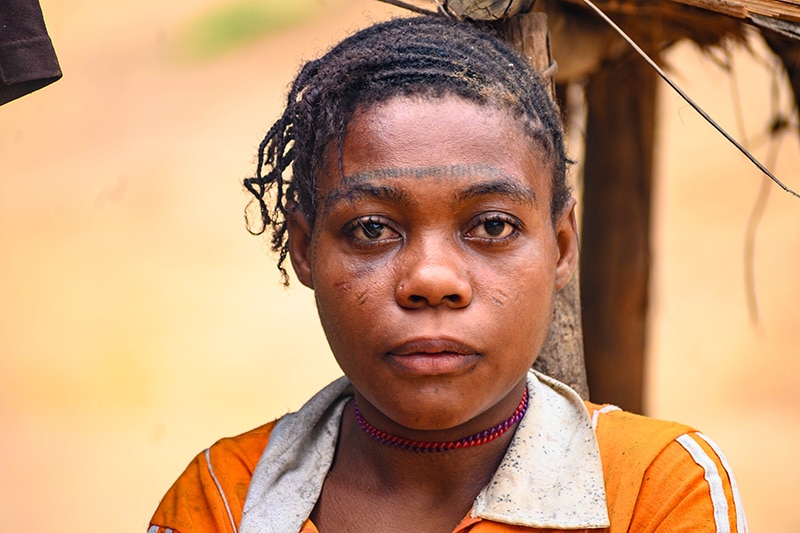
Living in hard-to-reach areas in tropical regions, often geographical, cultural, and lingual barriers stand between environmental funders and Indigenous Peoples and local communities who are often doing important environmental preservation work with little resources and support. Image © Well Grounded
What are the barriers?
There are many barriers between funders and grassroots or community-led organisations on the ground which prevent important streams of funding from amplifying the impact of vital projects. One of the first steps to creating a more equitable and impactful funding model is to recognise what these barriers are, from language and culture barriers and time-intensive funding applications to short-term funding cycles and top-down funding agreements.
Identifying partners
Often, a funder with a large amount to give away in grants will choose the easier path of making one large grant to a bigger organisation which can accept it, rather than investing in many smaller grants to smaller organisations. Also, finding new partners costs a funder more time and effort, increasing the amount of overhead and therefore detracting from a grant before it can reach its recipient. It is easier and faster to choose organisations that a funder already knows.
“Many funders offer their grants based on relationships,” says Annette Lanjouw, Chief Executive Officer of Arcus Foundation. “They fund based on people who they’ve talked to that have passion that they can identify with and develop trust with. It’s difficult for a funder to have those kinds of relationships with people who don’t speak the same language or who have a very different way of expressing themselves.”
A distant perspective
Most funders are based in the US or Europe and struggle to identify the groups on the ground who are doing the work they want to fund due to barriers such as geographical distance, language, and understanding of the local context. This in turn affects the relationships funders have with local organisations, and this needs to change, says John Kamanga, Co-Founder and Director of South Rift Association of Land Owners (SORALO):
“We need to push for more community-led conservation, rather than community-based conservation. A lot of the time, the funders and conservation gurus do not listen to local communities, but instead tend to come with pre-determined action.”
In a recent piece published in Mongabay, Byron Swift, Senior Advisor for wildlands at Re:wild, wrote “If you have chosen your grantees wisely, they will know a lot more than you will about how to spend the budgeted funds to achieve the mission objectives, especially as circumstances change. Putting the grantee in a straitjacket reduces programme effectiveness.”
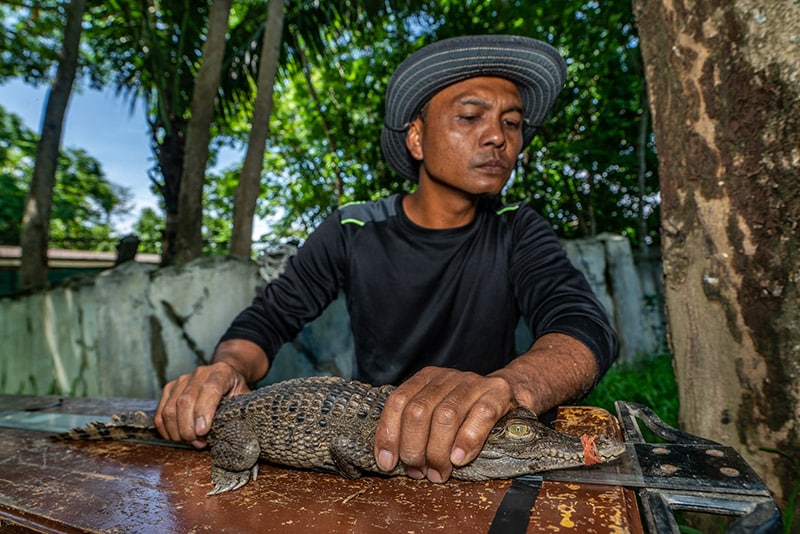
Synchronicity Earth’s Asian Species Programme has supported the Mabuwaya Foundation in the Philippines since 2014. Image © Chris Scarffe
Long-term relationship building
Another important issue which needs to be addressed in the future of environmental philanthropy is that of unrealistic short-term funding cycles.
“For a lot of the programmes that we run, it probably takes three or four years to actually get the communities on side, yet most of the grants end in two to three years. So, what happens is that only by the time the grant ends are we starting to actually get a meaningful relationship with the community,” adds John Kamanga.
Redressing the balance
Since the foundation of Synchronicity Earth in 2009, we have strived to learn from our partners about how we can best support them. We continue to develop strong, long-term relationships with them and explore how our approach to grant-giving can provide the support they need to prioritise their vital work over obligations to funders which may take up valuable time and resources. It is a continuous process, and we aim to continue to listen and improve as these relationships develop. One simple but important thing we have done is refer to the groups we fund as ‘partners’ rather than ‘grantees’. This change in vocabulary acts to continually reinforce that these groups are our equals, rather than simply recipients of funding.
When it comes to some of the barriers discussed above, we have adapted some of the traditional methods of grant-giving to try to address them.
Developing a team of regional affiliates
Synchronicity Earth’s office is based in London but our main areas of focus are in tropical regions such as Latin America, Central Africa and Southeast Asia. We have developed an affiliate model where our programmes receive important support from regional affiliates with close relationships with local stakeholders and knowledge of local issues. In 2021, affiliates Bihini Won wa Musiti Jean and Merline Touko Tchoko worked with Congo Basin Programme Manager Sophie Grange-Chamfray to hold a Mini-Congress for nature in Kinshasa when many of our Congo Basin partners were unable to attend the International Union for Conservation of Nature (IUCN) Congress in Marseille due to travel restrictions.
It was a great success, with Merline writing “We presented our work, showcasing our achievements in a range of different contexts throughout the Congo Basin. What a wonderful opportunity to meet all these tireless campaigners for land rights, to witness their evolution and growth and to receive their appreciation and advice! We voted together, celebrating when the INGA dam motion was passed.”
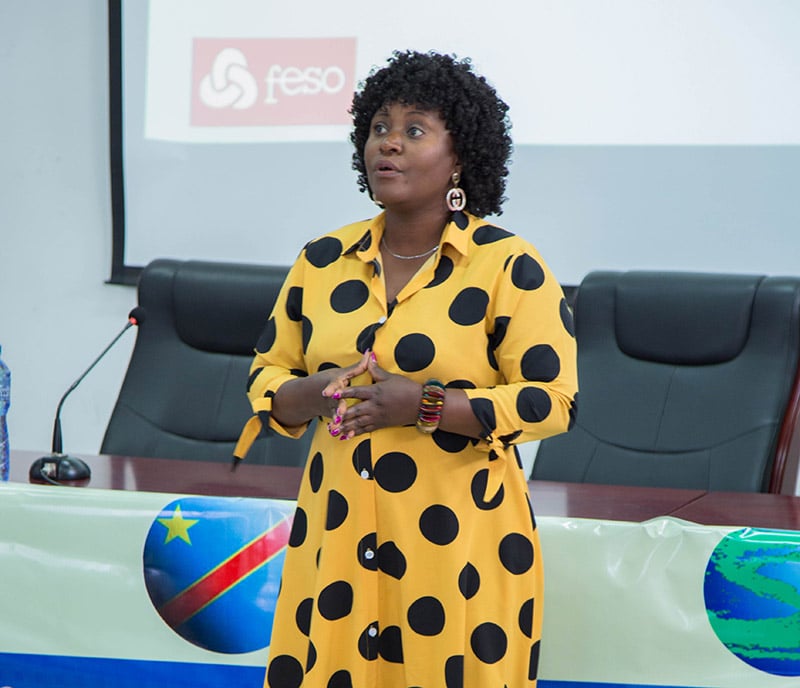
The Programs Coordinator of Femmes Solidaires (FESO), Mignonne Mbombo, gives a presentation at the Kinshasa Mini-Congress. Image © Rachidyikulu
Emphasis on relationships
The need for funders and grantees to be more collaborative, rather than top-down, is something which has shaped Synchronicity Earth’s approach to grantee relationships.
Rudo Sanyanga, an environmental scientist and activist based in South Africa, and former Head of the International Rivers Africa Programme, recently commented “As a grantee, I really like how Synchronicity Earth is not prescriptive. They would ask you what you were planning to do, how they could help, and then they pick from what you present to them what they’re going to support so that your work is impactful. That flexibility is what I think a lot of small NGOs like about working with Synchronicity Earth.”
In a recent survey of Synchronicity Earth’s partners, one partner said this about its relationship with our staff: “While the critical funding that Synchronicity Earth provides to our organisation is extremely valuable to us, we do also value the personal relationship that we have with the Synchronicity Earth team. It’s far more than a funding/reporting relationship. We know that we matter to Synchronicity Earth, that our work matters, and that our people matter.”
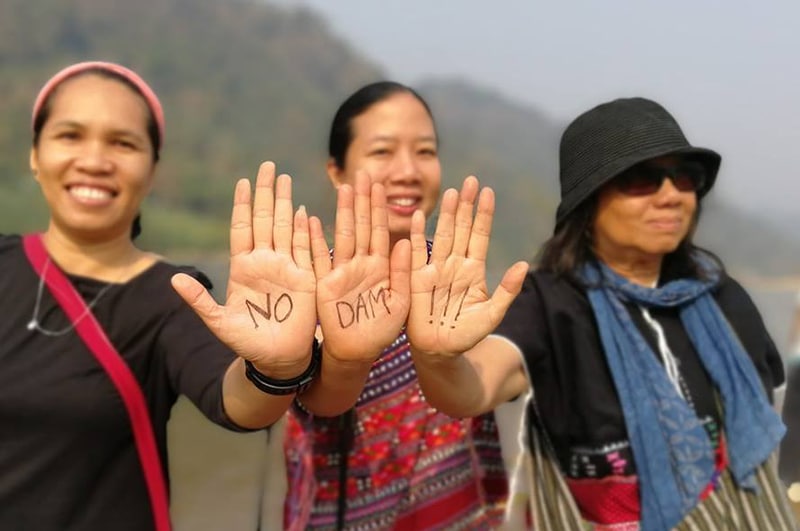
Synchronicity Earth has been supporting International Rivers since 2013. Image © International Rivers
Adapting reporting to make it more accessible
Further advice from Annette Lanjouw is that we need to address the processes around grant-giving:
“We need to open up the processes for grantees so that they are much more accessible for people who come from a different culture, have a different language, and may not have all the technological facilities. For example, they may actually be more comfortable giving an oral report versus a written report and finding out what adjustments you can make to create a big difference.”
By focusing on relationships between our team and our partners, we have been able to work out which methods of reporting best suit the people we are working with. For example, some of our partners prefer to report their updates to our team through a Zoom call rather than a written report as it takes up less time and makes it easier for them to answer questions.
Risk and collaboration
Another way to relieve the administrative burden on partners who have limited resources is to work as a funding community, not just an individual organisation.
Gemma Goodman, Head of Conservation Programmes at Synchronicity Earth says, “We need together as a donor community to figure out how to create mechanisms through which grantees can access long-term funds, while donors also feel that they have reduced risk, can find the right organisations, and keep the administrative burden down for everyone.”
“One thing that we try to do at Synchronicity Earth, and we’ve been doing this for 10 years and still have a lot to learn, is facilitate pooled funds. We use pooled funds for our Amphibian and Congo Basin programmes to enable a diversity of small local groups to be funded for longer periods, often for core funding.
“I wonder whether trusting one another is a way the donor community can reshape itself so we can have more of this type of collaboration for the benefit of our grantees.”
Another method we have been using specifically to counter short-term funding cycles and to be able to provide more long-term commitment to our partners is endowment funds. Donors who are willing to exchange short-term results for long-term impact can provide a grant which is invested, and each year the profits are spent down so partners of endowment funds such as the Ape Endowment and Amphibian Conservation Fund enable us to draw donors together for long-term support towards complex conservation issues.

One of the beneficiaries of long-term support from the Ape Fund is Hutan, an organisation in Malaysian Borneo with a women-led team reforesting degraded rainforest habitat for orang-utans and other threatened Bornean wildlife. Images: Hutan
Listening and continuing to learn
Reflecting on the Reverse the Red panel, Ameyali Ramos, International Policy Coordinator of the ICCA Consortium, said “I think we all agree that what’s happening on the front lines of conservation, especially by custodians in their territories of life is profoundly astounding. So, really, what we need to do is reimagine ourselves as funders. Partners don’t need to change the work they’re doing on the ground, we need to reflect and change ourselves.”
At Synchronicity Earth, we aim to continuously listen to our partners and adapt our approach in this changing world so we can support our partners, many of whom are led by Indigenous Peoples and local communities, as effectively as possible.
We have seen how trust-based approaches can help build meaningful, long-term relationships and events such as the panel quoted here (led by Reverse the Red) shows that there has been growing interest in these kinds of approach.
Synchronicity Earth is currently developing its long-term strategy with input from our partners and stakeholders, and we are delighted that the feedback from our grantees has been positive. However, we also realise that this is an ongoing learning process, the power dynamic between funder and grantee does not simply disappear overnight, and we will not always get it right.
But we shall continue to strive to improve our programmes and the way we work with our partners and supporters to be part of a movement putting trust at the heart of environmental philanthropy.
Conservation needs more funding, and it needs better funding. Synchronicity Earth hopes to lead by example and help shift environmental philanthropy so more support can reach the organisations and communities that are best equipped to enact change.
From our six conservation programmes to our endowment funds, find out more about Synchronicity Earth’s approach.

